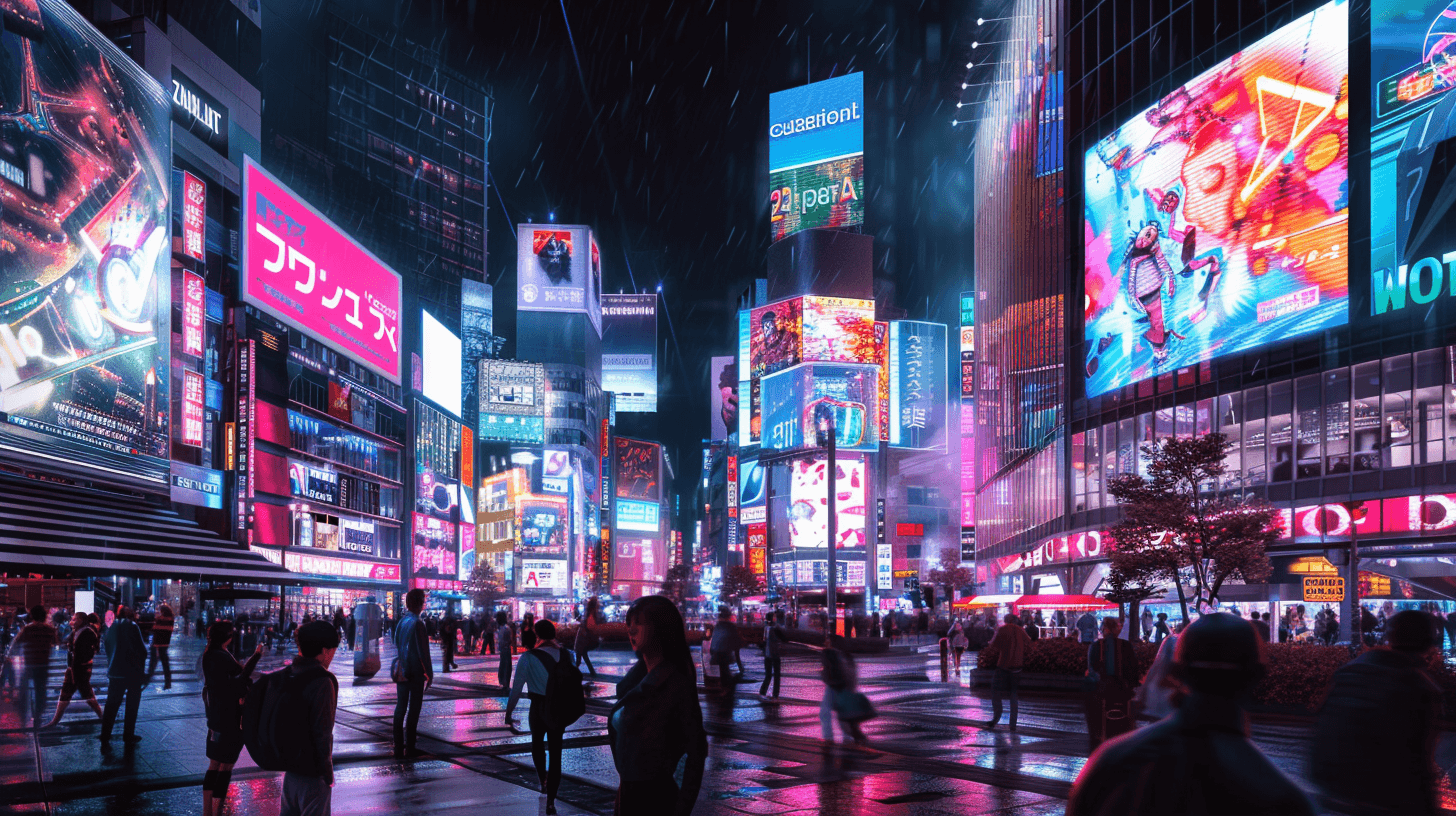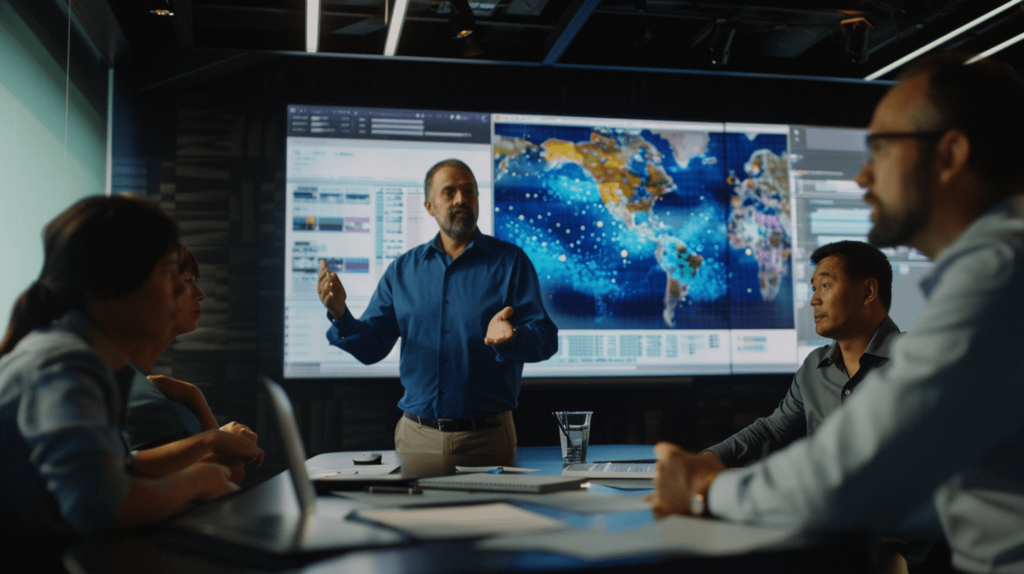Introduction

In today’s rapidly evolving digital marketing and communication landscape, the reliance on visual content has grown exponentially. As businesses vie for attention in an increasingly crowded digital space, the ability to captivate audiences through engaging visuals has never been more critical. This shift towards eye-catching, dynamic content sets the stage for an in-depth discussion on the pivotal role of motion graphics.
Motion graphics represent a vibrant intersection of graphic design and animation, breathing life into visuals in ways that static images simply cannot. These animated graphics enhance storytelling, simplify the conveyance of complex information, and significantly boost user engagement across various platforms. Whether it’s animating a logo on a website, enhancing a social media campaign, or enriching digital advertisements, motion graphics offer a unique capability to elevate a brand’s digital presence.
The purpose of this article is to guide you through the nuanced process of finding and hiring the right motion graphics designer. The choice of a skilled designer is crucial not only for creating visually appealing content but also for achieving your strategic marketing goals and engaging your audience effectively. The subsequent sections of this guide will delve into understanding what motion graphics entail, identifying your specific content needs, evaluating potential candidates, and fostering a successful collaboration with a motion graphics designer.
As we proceed, keep in mind that the integration of high-quality motion graphics can transform your digital strategies, making your content not only more engaging but also more memorable and effective. By the end of this guide, you’ll be equipped with all the necessary insights to enhance your visual content strategy and make informed decisions in your search for the perfect motion graphics designer. So, let’s embark on this visual journey together, and unlock the full potential of your digital content.
What is Motion Design / Motion Graphics?
Understanding Motion Graphics
In the realm of modern visual communication, motion graphics stand out as a transformative tool that merges graphic design with animation to produce engaging, visually compelling content. This dynamic medium is essential in today’s digital media landscape, offering a powerful means to convey complex information in an accessible and visually attractive manner.
Definition and Components of Motion Graphics
Motion graphics can be described as animated graphic design. This involves bringing visual elements like text and images to life through motion. The scope of motion graphics ranges from simple animated logos that catch the eye to intricate storytelling pieces that narrate a brand’s story or explain complex systems in an intuitive way.
The key components that make up motion graphics include:
- Animation: This is the core of motion graphics, where techniques like tweening, fading, and morphing breathe life into static images, making them move in a way that captures and holds the viewer’s attention.
- Typography: Motion graphics often utilize moving text to effectively engage viewers and communicate key messages. This dynamic text plays a crucial role in guiding viewers through the content, enhancing both the impact and understanding of the message.
- Cinematic Techniques: These involve the integration of video elements, visual effects, and sound design to enrich the narrative and emotional resonance of the content. Such techniques ensure that the final product isn’t just seen but is also felt by the audience.
Application Areas of Motion Graphics
Motion graphics are versatile and have been effectively utilized across various industries, each benefiting uniquely from their application:
- Marketing: In marketing, motion graphics are used to make advertising campaigns more eye-catching, thereby attracting attention quickly and explaining products in a straightforward yet memorable manner.
- Education: They simplify complex subjects and transform learning into a more enjoyable and engaging experience through animated diagrams and interactive storytelling.
- Entertainment: Motion graphics enhance entertainment media, adding depth to storytelling and viewer engagement through captivating visual effects.
- Corporate Communications: They are also used in corporate settings to explain and promote internal policies and external corporate messages in a way that improves retention and understanding among employees and clients alike.
Consider the versatility and effectiveness of motion graphics in enhancing digital content across different platforms. Think about how integrating motion graphics into your communication strategies could revolutionize the way you engage with your audience, making your messages not only more engaging but also more memorable.
The subsequent sections of this guide will delve deeper into how to find the right motion graphics designer to bring these dynamic visual elements to life for your specific needs. Remember, the right motion graphics designer is not just a technician but a creative partner who can transform your strategic vision into engaging visual stories.
By understanding the critical role motion graphics play in modern digital strategies, you are better equipped to make informed decisions that can significantly enhance your visual content and, by extension, your overall communication effectiveness. Engage with this exciting visual medium and see your digital content come alive like never before.
The Value of Professional Motion Graphics Designers

In today’s visually driven market, professional motion graphics designers play a pivotal role in enhancing a brand’s identity and presence. As companies vie for attention in an ever-saturated marketplace, the capacity to not only capture but also maintain audience interest is crucial. Motion graphics emerge as a powerful tool in this arena, offering dynamic visual experiences that significantly boost a brand’s recognition and recall.
Enhancing Brand Identity:
Motion graphics bring a brand’s visual identity to life, transforming it into something vibrant and dynamic. By incorporating movement and visual storytelling, these graphics make a brand more appealing and memorable to its audience. The sophistication and modernity of motion graphics can refresh a brand’s image, projecting innovation and relevance.
Integrating motion graphics into marketing campaigns allows for a consistent and engaging visual narrative that resonates deeply with viewers. Whether through explainer videos, social media animations, or digital advertisements, motion graphics provide a continuous thread that strengthens the brand’s story and values across all platforms.
Improving Engagement and Retention:
Statistical evidence underscores the effectiveness of motion graphics in capturing audience attention. For instance, viewers retain 95% of a message when they watch it in a video compared to 10% when reading it in text. Additionally, websites featuring videos can increase user engagement by as much as 80%, and the mere mention of the word ‘video’ in an email subject line boosts open rates by 19%.
The interactive and immersive nature of motion graphics significantly enhances viewer engagement. This heightened interaction is not just about viewing; it’s about experiencing the content, leading to better retention rates and more profound brand connections. Ultimately, this enhanced engagement translates into higher conversion rates and increased customer loyalty, as audiences feel more connected and responsive to the brand narrative.
Contextual Examples:
Consider the success stories of brands like Dropbox and Spotify, which have utilized motion graphics effectively to boost their market presence. Dropbox’s explainer video helped simplify its service’s understanding, contributing to a significant increase in user sign-ups. Similarly, Spotify uses motion graphics across its social media platforms to visually represent music and lifestyle, enriching user interaction and engagement.
Motion graphics are versatile and can be tailored to various formats and channels, making them invaluable across multiple platforms, including social media, television commercials, online ads, and educational materials. Their adaptability makes them ideal for reaching diverse audiences in a format that is most likely to capture their interest.
Investing in a skilled motion graphics designer is not merely an operational cost but a strategic decision that can dramatically enhance your brand’s competitive edge and market performance. Professional motion graphics services are an investment in your brand’s future, providing you with tools that are essential for standing out in today’s fast-paced digital world.
As you consider integrating motion graphics into your visual strategy, remember that this decision is pivotal in defining how effectively you can engage and retain your audience. The right motion graphics designer can transform your content from ordinary to extraordinary, ensuring that your message isn’t just seen—it’s remembered.
Pricing Motion Design
How to Find the Right Motion Graphics Designer
Selecting the right motion graphics designer is a pivotal decision that can significantly influence the success of your visual content strategy. This choice involves not only identifying a talented artist but also ensuring that the designer’s professional practices align with the goals and expectations of your project. This section explores the various avenues for hiring, assessing creative capabilities, and verifying professional reliability through social proof.
Freelance Platforms vs. Professional Agencies
Freelance Platforms: Platforms like Upwork, Behance, and Fiverr offer a broad spectrum of motion graphics designers ranging from budding creatives to seasoned professionals. Pros of using these platforms include competitive pricing and a vast selection of candidates, which allows for finding someone who closely matches your stylistic and project needs. However, cons include the potential variability in professionalism and quality, as well as the significant time investment required to sift through portfolios and vet candidates thoroughly.
Professional Agencies: Agencies provide a more streamlined and reliable avenue for hiring motion graphics designers. Pros include working with vetted professionals whose reliability and quality of work meet industry standards. Agencies often handle much of the administrative work,including contracts and consistent quality control, which can alleviate potential stress. However, the cons involve higher costs and possibly less flexibility in negotiating project terms that align with smaller budgets or less conventional project needs.
Portfolio Evaluation
When reviewing a designer’s portfolio, look for a diverse range of projects that showcase not only creativity and technical skill but also versatility. A robust portfolio should include examples of different types of motion graphics work, from commercial ads to educational videos, demonstrating the designer’s ability to adapt to various content styles and audience engagements. Assessing creativity involves looking for unique conceptual approaches and outstanding aesthetic quality that stands out from common trends.
Assessing Creativity and Versatility
It’s essential to evaluate the creativity displayed in the portfolio carefully. Look for innovative designs that push creative boundaries and show a deep understanding of visual communication. Versatility is equally important; it indicates the designer’s capability to handle various content types, adapting their style to fit the message and the target audience effectively.
Reading Reviews and Testimonials
Social proof is crucial in gauging a designer’s professional reliability and work ethic. Reviews and testimonials from past clients can provide valuable insights into the designer’s ability to deliver on promises, meet deadlines, and collaborate effectively. Positive feedback can reassure potential hires of the designer’s commitment to quality and client satisfaction, while negative reviews might highlight areas of concern.
Taking the time to thoroughly vet motion graphics designer candidates is crucial for establishing a successful partnership that will enhance your brand’s digital presence. This process, though potentially time-consuming, ensures that the professional you choose not only fits your artistic vision but is also capable of contributing positively to your project’s success. Use the strategies outlined in this section to navigate the hiring process effectively and secure a motion graphics designer who will bring your visual content to life, ultimately enriching your marketing efforts and strengthening your brand identity.
Vetting Potential Candidates
Selecting the right motion graphics designer is a pivotal decision that can define the success of your visual projects. A meticulous vetting process is essential not just to evaluate the technical skills and creativity of potential candidates but also to ensure they align with your project’s specific needs and your company’s core values. This process will help you identify a designer whose professional conduct and creative vision can significantly contribute to your project’s objectives.
Assessing Creativity and Technical Skills:
Begin with questions that delve into the candidate’s creative process. Ask, “Can you walk me through your design process for a recent project?” to gain insight into their conceptualization and execution phases. Inquire, “How do you incorporate feedback into your revisions?” to understand their responsiveness to input and ability to adapt their designs. These questions are crucial for assessing not only the candidate’s technical prowess but also their creative thought process and client interaction skills.
Problem-Solving Abilities:
Evaluate the candidate’s ability to handle pressure and complexity by asking scenario-based questions such as, “How would you manage a situation with multiple tight deadlines?” This helps you understand their prioritization, time management, and stress handling, which are vital attributes for dynamic project environments.
Practical Tests:
- Evaluating Compatibility:Discuss the relevance of assigning practical tests that reflect real-life tasks the designer would handle if hired. Explain how these tests are instrumental in assessing the candidate’s actual working style and output quality, ensuring they meet the project’s specific demands. This step is crucial for evaluating how well the candidate can translate briefs into compelling visual content.
- Setting Up Test Projects:Provide guidelines on how to design these tests fairly, ensuring they are both indicative of the job’s requirements and respectful of the candidate’s time. Consider compensated trial projects, which are an ethical way to assess compatibility while valuing the professional’s time and effort.
Importance of Feedback from Past Clients:
Emphasize the importance of contacting previous clients or employers to obtain feedback on the candidate’s professional reliability, quality of work, and ability to collaborate effectively. This feedback is invaluable as it provides a broader view of the candidate’s track record and work ethic.
What to Ask References:
Suggest specific questions for references that can reveal deeper insights, such as, “How did the candidate handle project deadlines?” or “Can you describe a challenging project they worked on and how they managed it?” These inquiries help gauge the candidate’s ability to navigate project challenges and their commitment to quality and timelines.
Reinforce that thorough vetting is crucial for hiring a motion graphics designer who will not only fulfill the creative demands of your projects but also gel well with your team’s dynamics and contribute positively over the long term. Urge the reader to view this vetting process as a crucial investment into their project’s and company’s future, ensuring that the partnership with the motion graphics designer is fruitful and aligns with strategic goals.
Throughout this section, maintain a direct and engaging tone, using “you” to directly address the reader. This approach personalizes the content, making it more actionable and ensuring that the reader is fully engaged and understands the importance of each step in the vetting process. This tone helps translate the procedural information into a compelling narrative that equips the reader to effectively find and select the best motion graphics designer for their needs.
Best Practices for Collaborating with a Motion Graphics Designer

Establishing a productive and enduring relationship with a motion graphics designer is crucial for achieving exceptional outcomes in visual content projects. This section outlines the foundational practices of effective communication, clear expectations, and adaptive feedback processes that underpin successful collaborations.
Effective Communication
Starting with open lines of communication is essential. Regular meetings—whether in-person, via video calls, or through frequent emails—help ensure all parties are aligned from the outset. It’s important to clearly articulate project goals, timelines, and deliverables during these interactions. This clarity helps both the client and the designer understand their roles and responsibilities, setting the stage for a smooth workflow.
Establishing Clear Expectations
Setting clear, measurable expectations for each phase of the project is critical. Define specific milestones, such as deadlines for drafts and details of design requirements. If your brand has specific guidelines, make these known to avoid revisions later. Clear expectations not only help in managing the project timeline but also reduce the potential for misunderstandings, ensuring the project execution progresses as planned.
Feedback Loops
Integrating structured feedback sessions into the project timeline is vital. These should be aimed at reviewing progress, providing constructive criticism, and discussing necessary adjustments. Regular feedback ensures the project stays on track and both parties maintain a mutual understanding of the project’s evolution. Emphasize the importance of timely feedback, as delays can impede project momentum and affect deadlines.
Adapting to Feedback
Be open to incorporating the designer’s creative insights. A motion graphics designer’s expertise can bring significant added value to the project, often in ways not initially anticipated. Encourage flexibility in integrating these suggestions, which can lead to enhanced project outcomes.
Moreover, be prepared to adapt the project based on the feedback from both sides. This might mean revisiting the scope of the project or adjusting deliverables to better meet the evolving needs of the project without compromising its integrity or objectives.
Emphasizing the benefits of a synergistic partnership with your motion graphics designer. Through effective communication, structured feedback, and adaptability, projects are not only completed successfully but can also exceed expectations. Encourage readers to view these collaborative practices not merely as project management tasks but as crucial elements in building a lasting professional relationship that can evolve and adapt over time.
This approach not only fosters a productive working environment but also ensures that motion graphics projects significantly contribute to the strategic goals of the business, enhancing both brand visibility and audience engagement.
Long-Term Engagement Strategies

A strong partnership with a motion graphics designer involves more than just the occasional project engagement; it requires a foundation of regular communication, shared objectives, and mutual respect. Implementing regular strategy meetings to discuss both upcoming projects and long-term goals ensures that both parties are not only aligned but also deeply committed to the brand’s ongoing success. Such alignment fosters a collaborative environment where innovative ideas flourish.
Trust and Reliability:
Over time, as trust builds, a motion graphics designer can become increasingly attuned to your business’s needs, often anticipating challenges and proposing creative solutions proactively. This kind of relationship enables the designer to integrate more seamlessly with your team, understanding your market and target audience as well as any in-house colleague would.
Continuous Learning:
Encouraging Professional Growth:
To keep the content fresh and engaging, it is essential to encourage and support your motion graphics designer’s professional growth. Staying abreast of the latest design tools, trends, and techniques is crucial for maintaining competitive edge. Facilitate this by providing access to training courses, workshops, and industry seminars.
Sharing Resources and Opportunities:
Investing in your designer’s growth not only enhances the quality of their output but also fosters loyalty and dedication. Offering resources for continuous improvement demonstrates a commitment to their professional development, which is often reciprocated through innovative and dynamic content creation.
Benefits of Retainer Agreements:
Establishing a retainer agreement with your motion graphics designer solidifies the partnership, providing both parties with predictability and stability. This kind of arrangement benefits the business through budget consistency and ensures that the designer is available when needed.
Setting Up Retainer Agreements:
Negotiate retainer agreements that outline clear expectations regarding availability, deliverables, and payment schedules. It’s crucial to maintain flexibility within these agreements to allow for adjustments as your business needs evolve, ensuring that the partnership remains beneficial for both sides.
Nurturing a long-term partnership with a motion graphics designer is an investment in your business’s future. Such relationships enhance not only the continuity and quality of your visual content but also ensure that it remains aligned with your strategic marketing objectives. By embracing these engagement strategies, you demonstrate a commitment to not just the success of individual projects but to the overarching growth and innovation within your brand. Engaging directly with your motion graphics designer as a trusted partner will invariably lead to richer, more impactful visual content that drives your business forward.
Conclusion
In this guide, we’ve explored the critical role motion graphics play in enhancing digital marketing and communication efforts across various industries. From the foundational understanding of what motion graphics are—including their key components like animation, typography, and cinematic techniques—to their application in boosting brand identity and viewer engagement, we’ve covered the essentials to equip you with the knowledge necessary for hiring a skilled motion graphics designer.
Now, with a clear understanding of the process—from evaluating portfolios on platforms like Upwork and Behance, to conducting interviews and practical tests—it’s time for you to take action. You are well-prepared to select a motion graphics designer who not only meets your creative needs but also fits well with your strategic objectives. Utilize the outlined criteria and approaches to navigate the hiring process confidently and effectively.
As we conclude, remember that incorporating high-quality motion graphics into your strategy is more than an aesthetic enhancement. It’s a powerful tool that can significantly improve engagement, enhance your brand’s visual narrative, and contribute to your business’s growth and success in the competitive digital marketplace. Motion graphics are not just about making things look good—they are about making your brand unforgettable.
Take this knowledge and start your search for a motion graphics designer today. With the right partner, you can transform your visual content and make a lasting impact on your audience. Let the journey to elevating your digital content begin now, and watch as your brand takes a significant leap forward in capturing and captivating your target market.




